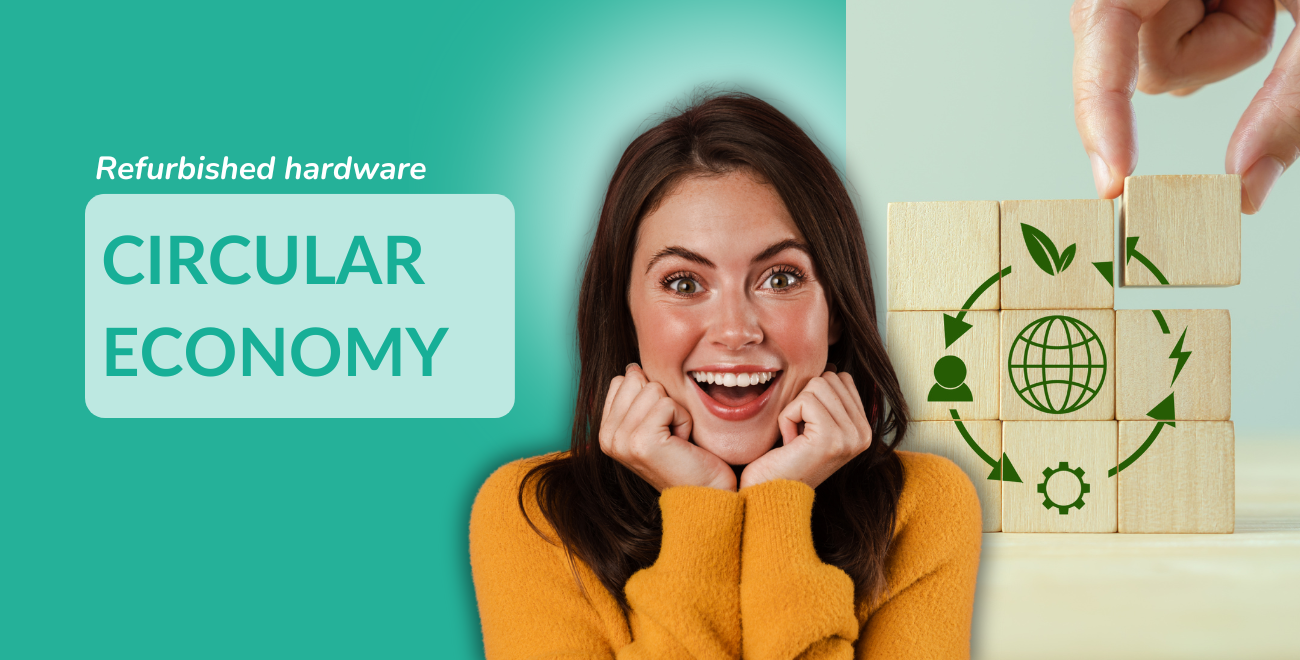03/09/2023

Refurbished hardware and the circular economy
Every day we use numerous raw materials. Some are more harmful to the environment than others. The problem with extracting raw materials is that it releases a huge amount of CO2. If we want to combat climate change and significantly reduce CO2 emissions, we need to find smarter ways to manage our resources in the future. Our current system needs a drastic overhaul. But how? Ever heard of the circular economy?
Circulating raw materials and products is, of course, always better than making new products. To clarify: making a new Apple iPhone emits approximately 27kg of CO2. A reused smartphone emits 7kg of CO2. The math is simple—by choosing a second-hand or refurbished smartphone instead of a new one, you save approximately 20kg of CO2.
In the future, the purchase of new hardware will increasingly decline. A circular economy is a significant change but also a necessary one. If we want to leave a habitable planet for future generations, transitioning to a circular economy is a smart move. Plus, new hardware is often much more expensive than refurbished hardware—making it a win-win situation!
Circular Economy Meaning
By 2050, the Dutch government wants the entire Netherlands to be fully circular. But what does circular mean, and what does that look like? The literal meaning of 'circular' is revolving. It has to do with things moving in a loop. When applied to the economy, it means that raw materials and products are reused. By reusing raw materials and products, fewer or no new materials need to be extracted. Likewise, fewer or no new products need to be made. This saves a lot of CO2, helping to combat climate change. In practice, it is unfortunately not possible to fully circulate products and raw materials 100%, but we strive to do our best to achieve maximum results.Circulating raw materials and products is, of course, always better than making new products. To clarify: making a new Apple iPhone emits approximately 27kg of CO2. A reused smartphone emits 7kg of CO2. The math is simple—by choosing a second-hand or refurbished smartphone instead of a new one, you save approximately 20kg of CO2.
Circular Economy Examples
In the previous paragraph, we briefly mentioned the term 'refurbished.' Refurbishing means professionally overhauling previously used equipment. It’s not just about sprucing up a device; it's much more. The device is thoroughly tested and repaired if necessary. Refurbishing devices is a great example of how the circular economy will look in the future. In the case of refurbished equipment, no new raw materials are extracted—they are reused. The loop is then closed.Why a Circular Economy?
As previously mentioned, the Dutch government aims to have a circular economy by 2050, indicating that the circular economy is the future. There are several good reasons why this is the case.Less Environmental Damage
By transitioning to a circular economy, the environment will be significantly relieved. There will no longer be a need to search for rare raw materials like minerals, gold, and various metals. Additionally, less e-waste will be produced. E-waste refers to electronic waste. Taking the refurbished industry as an example, its impact on the environment is about three times less than producing a new device.Less Health Damage
Extracting new raw materials for products like electronic devices releases many toxic substances. These toxic substances often end up in water, contaminating freshwater supplies, making the water unsafe to drink. In some parts of the world, flooding is already increasing. By no longer relying on new raw materials, fewer toxic substances will be released. Additionally, the growing pile of e-waste not only harms the environment but also human health. In West Africa and Asia, there are so-called illegal dumping sites where people burn electronic waste daily without any protection. The substances they inhale are extremely harmful to their health.In the future, the purchase of new hardware will increasingly decline. A circular economy is a significant change but also a necessary one. If we want to leave a habitable planet for future generations, transitioning to a circular economy is a smart move. Plus, new hardware is often much more expensive than refurbished hardware—making it a win-win situation!
